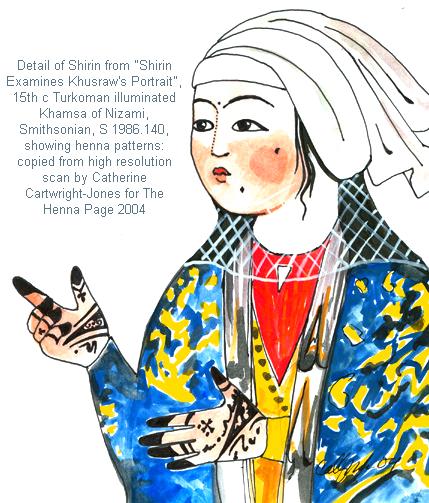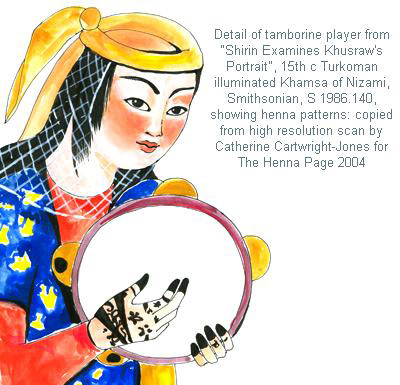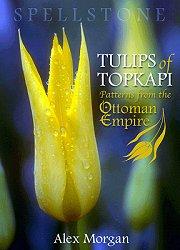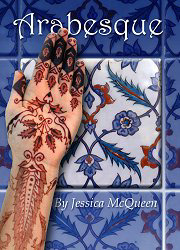|
Khamseh of Nizami: The Origins of Ottoman Henna Patterns Catherine Cartwright-Jones © 2004  Detail traced from high resolution scan of Shirin Examines Khusraw’s Portrait S 1986.140 Khamsa of Nizami, Turkoman, late 15th century Entire Image 4 ½ by 3 11/16 inches (11.5 x 9.4 cm) Detail area above is an enlargement of approx. 1/2" by 1/2", (1 cm x 1 cm) of original illumination Arthur M Sackler Gallery, Smithsonian Institution, Smithsonian Unrestricted Trust Funds, Smithsonian Collection Acquisition Program and Dr. Arthur M Sackler Shirin
Examines Khusraw’s Portrait, S 1986.140 is from an illuminated Khamsa of Nizami. It was
created in the Turkoman court in western Iran in the late 15th
century. This manuscript is typical of Turkoman 15th century
manuscripts. This illustration and its henna are in the style of the
Turkoman court in late 14th to mid 15th century. During this period,
the Turkomans held an Ottoman principality on the eastern border of the
Byzantine Empire in present day western Iran.. The Turkoman leader
Fatih Sultah Mehmet II conquered Istanbul in 1453, establishing the
Ottoman Empire, and brought Turkoman culture into Turkey as well as
Turkoman political power. There is little evidence that henna was
used as body ornamentation in the Byzantine Empire, and no evidence
that the Turkoman style patterning existed in Anatolia before they
entered the area.
In the Sackler Gallery’s Turkoman Khamsa there are many depictions of women with henna patterns. In the illumination Shirin Examines Khusraw’s Portrait, there are ten women. Four of the ten have hennaed hands. Though the hands are no more than 1/8th inch or .25 cm wide, there is enough detail to clearly discern pattern characteristics. These woman’s hands have wedge shaped henna areas, with indication of patterning within the wedge, and additional pattern outside the wedges, including what appear to be written words. These are stylistically identical to the wedge shaped henna patterns in the Codex Vidobonensis and the Ravzat el Usak of Arifi. Bold patterns were not the only henna patterns used in Ottoman Turkey, as the patterns on the Sahkulu Peri, drawn in 1550, are delicate and complex, similar to Shiraz style henna patterns from the 1530's. The bold patterns seem to have been popular in Turkey, and remained popular, as they were the kind most frequently depicted on Ottoman women from the 16th century to the 19th century. These illustrations were created by tracing and hand painting high-resolution scans from Shirin Examines Khusraw’s Portrait S 1986.140, to create the most accurate possible representation of henna as it was depicted. The hands and feet in the original art are very small, only 1/8" x 1/4", or .25 to .5 cm. It may be assumed that the artist was hampered by the scale of this illumination, so the henna probably was much more finely detailed. The position and general shape of the patterning is easy to verify and has been traced exactly. I have not attempted to reconstruct the patterns in these images, only to copy precisely what was painted in the original illumination.  Detail traced from high resolution scan of Shirin Examines Khusraw’s Portrait S 1986.140 Khamsa of Nizami, Turkoman, late 15th century Entire Image 4 ½ by 3 11/16 inches (11.5 x 9.4 cm) Detail area above is an enlargement of approx. 1/2" by 1/2", (1 cm x 1 cm) of original illumination Arthur M Sackler Gallery, Smithsonian Institution, Smithsonian Unrestricted Trust Funds, Smithsonian Collection Acquisition Program and Dr. Arthur M Sackler References: Akurgal, E. The Art and Architecture of Turkey Rizzoli, 1980 Atil, E. The Age of Sultan Suleyman the Magnificent Harry N. Abrams, Inc., New York Barber, N. "The Sultans" Simon and Schuster, New York, 1973 "Codex Vindobonensis" 1590 Croutier, Alev Lytle “Harem: The World Behind the Veil” Abbeville Press 1989 da Zara, Bassano “I Costumi et I modi particolari de las vita de Turchi” 1545 Penzer, N. M. "The Harem" Bookplan, 1936 Wheatcroft, A. The Ottomans Viking, 1993 
 Alex Morgan's Tulips of Topkapi and Jessica McQueen's Arabesque have beautiful henna patterns adapted from Ottoman art! Available through TapDancing Lizard The Henna Page Main Index http://www.hennapage.com/henna/mainindex.html *"Henna,
the
Joyous Body Art"
the Encyclopedia of Henna Catherine Cartwright-Jones © 2000 registered with the US Library of Congress TXu 952-968 |